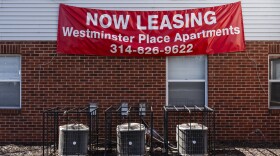The cost of renting a place to live is steadily dropping around the country from from pandemic highs, but the Midwest continues to see rising prices.
Data from Realtor.com shows the nationwide median rent has decreased by roughly 2.3% over the past six months.
But Midwestern metros aren’t seeing that reduction. In fact, the region has seen faster rent increases than any other region in the past six months, according to the data.
Realtor.com research analyst Hannah Jones said the rental affordability Midwesterners typically flaunt has turned into a headache.
“The Midwest tends to be more affordable, which is driving up demand,” Jones said. “But because of that demand coming in we’re seeing faster rent growth.”
That’s right. The Midwest’s relatively cheap housing is now acting as a catalyst for rising rent. Jones said it’s a major reason the Midwest hasn’t seen the slight reprieve in rent prices the rest of the country has seen over the past six months.
”When supply is limited and the demand is high that means the prices are going to continue to accelerate,” Jones said.
Tara Raghuveer, founder of the KC Tenants Union, is worried.
“People are suffering intensely. People are in so much pain and the rent is the critical pain point,” she said.
To make matters worse, Jones said high mortgage rates and a still-competitive real estate market are keeping prospective homeowners stuck in the rental market, contributing to steeper prices.
Mortgage rates reached a high of 8% percent in October, a massive shift from the record low rates seen during the pandemic.
Nationwide, rent prices have declined steadily over the past six months. As of December, median rent for a two-bedroom apartment stood at $1,923, according to Realtor.com’s most recent rent report in October. That’s $44 lower than when the average peaked in July.
Even though regional costs are lower than they are nationally, rent is higher than many Midwesteners are used to.
Realtor.com provided the Midwest Newsroom with median monthly rental prices for two-bedroom apartments in a number of metro areas around the region.
Omaha, Nebraska, was the most expensive, with the median rent at $1,650.
Next was Kansas City, Missouri, where the median rent was $1,300. Close behind was St. Louis at $1,283. Des Moines, Iowa, had a median rent of $1,150.
A dire situation

“The rent is too damn high, it has been for too long and it's even more extreme since the first few years of the pandemic,” said Raghuveer.
Raghuveer also works on the Homes Guarantee campaign, an organization of more than 50 tenant groups across 24 states advocating for fair housing laws nationwide. She described the situation in Kansas City and the region as “dire.”
“The rent is the biggest bill for most poor and working class families every month,” Raghuveer said.
The median rent in the U.S. is still less than the record high it reached in the fall of 2022, Raghuveer pointed out. But, she said, renters are still paying far more than they were pre-pandemic. In fact, while the median rent nationwide is slowly declining, it still remains $301 higher than where rent stood in the fall of 2019.
What’s more, Raghuveer said the high demand for rental stock has made it easier for landlords and big company property holders to raise rent. She said for some tenants, that can be a slow path to an eviction.
Easing the pain?
Help could be on the way.
Mortgage rates dipped in December, to 7%. That could spur some renters to buy homes, freeing up some rental stock.
According to U.S. Census data, the number of new rental units in the Midwest is growing steadily. Jones said that by Fall 2024, the Midwest will have an estimated 9 million units of rental housing, 2.3 percent more than in fall 2019.
That could help ease prices, Jones said.
“With the housing market as a whole we’re not expecting it to become affordable all of the sudden, but to make some baby steps in that direction,” Jones said.
Raghuveer said new construction doesn't always lead to lower prices — especially in metro areas where developers often focus on providing amenities to attract high-income renters.
Still, Raghuveer remains hopeful. She said as more tenant unions pop up nationwide, renters are getting more protections, like in Kansas City, Missouri where the city council passed a tenant bill of rights.
But Raghuveer said change is coming slowly.
“We’re on the brink of a real reckoning in this country about the rent.” she said. “The fear is that it may take a while for our policy makers to get it.”
This story comes from the Midwest Newsroom, an investigative journalism collaboration including IPR, KCUR 89.3, Nebraska Public Media News, St. Louis Public Radio and NPR.
Copyright 2023 KCUR 89.3. To see more, visit KCUR 89.3. 9(MDA4OTAxNzAzMDEzMjc0MTc2MzA5ZDZlMw004))





